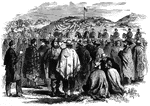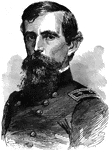Clipart tagged: ‘Fort Donelson’

Attack of the Gunboats at Fort Donelson
Attack of the gunboats at Fort Donelson, one of the most influential battles in American history. This…

Confederate Prisoners
"Group of Confederate prisoners captured at Fort Donelson, on the morning after the surrender, clothed…

Fort Donelson
Fort Donelson and Fort Heiman, two sites of the American Civil War Forts Henry and Donelson Campaign,…

Storming of Fort Donelson
"Storming of Fort Donelson- decisive bayonet charge of the Iowa Second Regiment on the Confederate intrenchments…

Lewis Wallace
"General Lewis Wallace, born in Brookville, Frankly County, Ind., April 10th, 1827, served in the Mexican…
